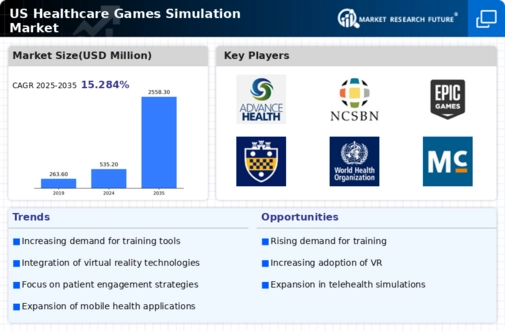Advancements in Virtual Reality Technology
The healthcare games-simulation market will transform due to advancements in virtual reality (VR) technology. As VR becomes more accessible and affordable, its application in healthcare training is expanding. This technology allows for immersive experiences that can replicate complex medical scenarios, providing learners with hands-on practice in a controlled setting. The integration of VR into simulation games enhances engagement and retention, making training more effective. Market analysis suggests that the VR segment within the healthcare games-simulation market could reach $1 billion by 2027, driven by increasing adoption among medical schools and training institutions. This trend indicates a shift towards more sophisticated training methodologies that leverage cutting-edge technology.
Increasing Demand for Interactive Learning
the healthcare games-simulation market is experiencing a notable surge in demand for interactive learning solutions. As educational institutions and healthcare organizations seek innovative methods to enhance training, the integration of simulation-based games becomes increasingly appealing. This trend is driven by the need for effective skill development and knowledge retention among healthcare professionals. According to recent data, the market for educational games in healthcare is projected to grow at a CAGR of 15% over the next five years. This growth reflects a broader shift towards experiential learning, where participants engage in realistic scenarios that mimic real-life challenges. Consequently, the healthcare games-simulation market is positioned to play a pivotal role in shaping the future of medical education and training.
Rising Awareness of Mental Health Training
The growing awareness of mental health issues is driving demand for specialized training solutions within the healthcare games-simulation market. As mental health becomes a focal point in healthcare discussions, there is a corresponding need for training programs that equip professionals with the skills to address these challenges effectively. Simulation games that focus on mental health scenarios allow healthcare workers to practice empathy and communication skills in a safe environment. This trend is reflected in the increasing number of training programs incorporating mental health simulations, which are projected to grow by 20% over the next few years. The healthcare games-simulation market is thus likely to expand as organizations seek to enhance their workforce's capabilities in this critical area.
Focus on Patient Safety and Quality Improvement
In the healthcare sector, there is a heightened emphasis on patient safety and quality improvement, which significantly influences the healthcare games-simulation market. Simulation-based training tools are increasingly recognized for their ability to provide safe environments for healthcare professionals to practice critical skills without risking patient safety. This focus aligns with national initiatives aimed at reducing medical errors and enhancing care quality. Thus, the healthcare games-simulation market is likely to see increased investment. Organizations are prioritizing training solutions that foster a culture of safety. Reports indicate that organizations investing in simulation training can reduce errors by up to 30%, underscoring the potential impact of these tools on healthcare outcomes.
Regulatory Support for Innovative Training Solutions
Regulatory bodies in the healthcare sector are increasingly recognizing the value of innovative training solutions, which positively impacts the healthcare games-simulation market. Supportive policies and funding initiatives aimed at promoting simulation-based education are emerging, encouraging healthcare organizations to adopt these tools. This regulatory backing is crucial as it not only legitimizes the use of games and simulations in training but also provides financial incentives for their implementation. As a result, the healthcare games-simulation market is likely to benefit from increased funding opportunities, enabling the development of more advanced and effective training solutions. This trend suggests a growing alignment between regulatory frameworks and the evolving needs of healthcare education.


















Leave a Comment